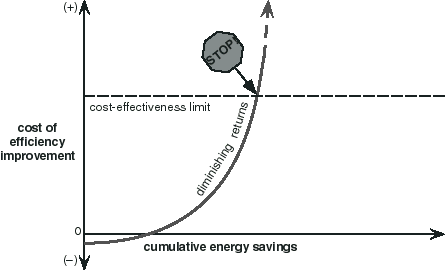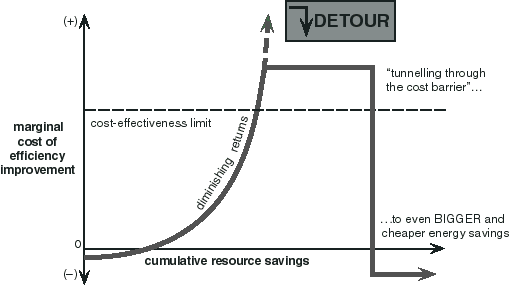 | |||||||||||||||
| |||||||||||||||
- Improving mindware -- Optimize without compromise -- More costs less -- Seeing the obvious sooner -- Big pipes, small pumps -- Optimizing the system -- Like eating a lobster -- Thinking backward -- Doing things in the right order -- Solving for pattern
The examples of the hypercar, advanced industrial and materials techniques, and green buildings all demonstrate that design is really just applied foresight. It's what you do now carefully and responsibly to achieve what you want later.
By the time the design for most human artifacts is completed but before they have actually been built, about 80-90 percent of their life-cycle economic and ecological costs have already been made inevitable. In a typical building, efficiency expert Joseph Romm explains, "Although up-front building and design costs may represent only a fraction of the building's life-cycle costs, when just 1 percent of a project's up-front costs are spent, up to 70 percent of its life-cycle costs may already be committed. When 7 percent of project costs are spent, up to 85 percent of life-cycle costs have been committed." That first one percent is critical because, as the design adage has it, "All the really important mistakes are made on the first day." This chapter presents ways to think differently-to use a different design mentality-on that first day.
We can make no better higher-leverage investments for the future than improving the quality of designers' "mindware", assets that, unlike physical ones, don't depreciate but, rather, ripen with age and experience. Senior mechanical engineer Eng Lock Lee offers the following example. A typical colleague may specify nearly $3 million worth of heating, ventilating, and air-conditioning (HVAC) equipment every year, enough to raise a utility's summer peak load by a megawatt. Producing and delivering that extra megawatt conventionally requires the utility to invest several million dollars in infrastructure. If better engineering education were ultimately responsible for the equipment's being made 20-50 percent more efficient (a reasonably attainable and usually conservative goal), then over a 30-year engineering career, the utility would avoid about $6-15 million in present-valued investments per brain, without taking into account any of the savings in operating energy or pollution. This returns at least a hundred to a thousand times the extra cost of that better education. The savings would cost even less if good practitioners disseminated their improved practices through professional discourse, mentoring, or competition, so that educating just one engineer could influence many more. In addition, a good engineer's lifetime designs can improve comfort for perhaps 65,000 office workers, whose 30-year present-valued salary totals about $36 billion. If increasing their comfort will increase their productivity on the lines suggested by the evidence mentioned in chapter 5, then society can gain perhaps a million times more benefit than the additional cost of the better engineering education.
Many architects, engineers, and other designers, however, are not being well taught. J. Baldwin, long the technology editor of Whole Earth Review, was told on his first day in design school that "design is the art of compromise." Design, he was instructed, means choosing the least unsatisfactory tradeoffs between many desirable but incompatible goals. He believed that this formulation described "a political technique masquerading as a design process," and he realized it was wrong. His inspiration came as he gazed out the classroom window and saw a pelican catching a fish. For the past 3.8 billion years or so, nature has been running a successful design laboratory in which everything is continually improved and rigorously retested. The result, life, is what works. Whatever doesn't work gets recalled by the Manufacturer. Every naturalist knows from observation that nature does not compromise; nature optimizes. A pelican, nearing perfection (for now) after some 90 million years of development, is not a compromise between a seagull and a crow. It is the best possible pelican.
A pelican, however, is not optimized within a vacuum. It exists in an ecosystem, and each part of that ecosystem, in turn, is optimized in coevolution with the pelican. A change in the pelican or in any aspect of its ecosystem could have widespread ramifications throughout the system, because all its elements are coevolving to work optimally together. For the same reason, an engineer can't design an optimal fan except as an integral part of its surrounding cooling system, nor an optimal cooling system without integration into the building around it, nor an optimal building without integration into its site, neighborhood, climate, and culture. The greater the degree to which the components of a system are optimized together, the more the tradeoffs and compromises that seem inevitable at the individual component level becomes unnecessary. These processes create synergies and felicities for the entire system. And this in turn exposes a core economic assumption as a myth.
TUNNELING THROUGH THE COST BARRIER
Economic dogma holds that the more of a resource you save, the more you will have to pay for each increment of saving. That may be true if each increment is achieved in the same way as the last. However, if done well, saving a large amount of energy or resources often costs less than saving a small amount. This assertion sounds impossible, and indeed, most economic theorists can "prove" it won't work. Blissfully unaware of economic theory, however, intelligent engineers put it into practice every working day as part of an approach called whole-system engineering.

If you build a house, you'll be told that thicker insulation, better windows, and more efficient appliances all cost more than the normal, less efficient versions. If you build a car, you'll be told that lighter materials and more efficient propulsion systems are more expensive options. These statements are often true, but at the level of single components considered in isolation. On the cost-versus-savings graph shown above, as you save more energy (that is, as you move from the lower left end of the curve toward the right), the cost of saving the next unit of energy initially rises more and more steeply. This is called "diminishing returns." When you've struggled up to the limit of cost-effectiveness, you should stop additional outlays of money, because they're no longer justified by their results. This part of the curve illustrates the common principle that better usually costs more, a principle that has taken a death grip on our consciousness.
Actual engineering practice, however, presents a different possibility. Only recently noticed is an additional part of the curve further to the right (see the graph below): There, saving even more energy can often "tunnel through the cost barrier," making the cost come down and the return on investment go up. When intelligent engineering and design are brought into play, big savings often cost even less up front than small or zero savings. Thick enough insulation and good enough windows can eliminate the need for a furnace, which represents an investment of more capital than those efficiency measures cost. Better appliances help eliminate the cooling system, too, saving even more capital cost. Similarly, a lighter, more aerodynamic car and a more efficient drive system work together to launch a spiral of decreasing weight, complexity, and cost. The only moderately more efficient house and car do cost more to build, but when designed as whole systems, the superefficient house and car can often cost less than the original, unimproved versions.

There are two main ways to achieve this more-for-less result. The first is to integrate the design of an entire package of measures, so that each measure achieves multiple benefits, such as savings on both energy and equipment costs. The second method is to piggyback on improvements being made anyway for other reasons, such as renovation of aging equipment, renewal of deteriorating building facades, or removal of such hazards as CFCs, asbestos, and PCBs. These two practices, which can also be combined, rely not on some arcane new technology but on well-known engineering fundamentals rigorously applied. A well-trained engineer will be guided by the following three precepts:
- The whole system should be optimized.
- All measurable benefits should be counted.
- The right steps should be taken at the right time and in the right sequence.
(End of excerpt)
Download the entire chapter (PDF-124k)
 |
|
To make comments or report problems with this site, please contact webmaster@rmi.org. © All rights reserved. Published by Rocky Mountain Institute. 2317 Snowmass Creek Road | Snowmass, CO 81654-9199 | Ph: 970.927.3851  Powered by Intrcomm Technology's SMC |







